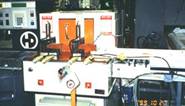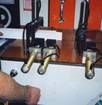 Loading... Please wait...
Loading... Please wait...(800) 346-8274
Free Ground Shipping on Orders over $150!
Over 23,000 Items Discounts up to 40% off Retail
Cermet II Saw Blades in Industrial Applications
Our Newsletter
- Home
- Technical Info
- Carbide Parts
- Cermet II Saw Blades in Industrial Applications
Cermet II Saw Blades in Industrial Applications
Cermet II Saw Tips have been used to solve many customer problems and increase cutting speed and wear resistance. See some of the reviews customers have given the Cermet II Saw Blades.
Cermet Saw Blades in Industrial Applications
Titanium Carbonitride (TiCN cermet) is new in brazed saws but proven for years in mechanically held applications. TiCN cermet ceramic is different than tungsten carbide the same way rock maple is different than pine. Rock maple is harder and wears better and much longer. TiCN saw tips and ceramic tipped saws are much harder to make than tungsten carbide saws. They also make saws that cut easier, stay sharper longer, run quieter, cleaner and cooler.
Below are the results of industrial tests showing the material cut, machine used and results.
Cherry - table saw, hand fed - Much better than carbide - see Kwan report
Non-ferrous - table saw, hand fed - Cooler cuts, 50% longer life
Red oak - table saw, hand fed - Much better than carbide - see Koschman
General wood - table saw, hand fed - Much better than carbide - see Stubbs
5 Hardwood species - table saw, hand fed - Much better than carbide - see Sharp
Hard & soft woods - Chop saw, manual - As good as carbide with no breakage
Dry maple and alder - saw mill cutoff saw – Excellent, much longer life
Sheet rock (gypsum) - standard gypsum line - As good as carbide
Melamine - SCMI sliding Table - 6:1 life over carbide and very clean cuts
P-lam - SCMI sliding Table - 6:1 life over carbide and very clean cuts
Particleboard - SCMI sliding Table - 5:1 life over carbide
Cedar for windows - miter saw - Clean cuts, stayed very sharp
Cermets Cutting Slats
This is a company manufacturing products where a very large number of slats are required for each item. They were concerned with time spent cutting but they were much more concerned with good cuts every time. The cost of sorting sloppy cuts was huge. The cost of sorting poor cuts was much more important than tooling cost or material cost. The Cermets made much cleaner cuts. Cermet tipped saws cut 30 slats at a time compared to only 14 for carbide tipped saws. The cuts were also cleaner. The top bundle of 14 slats has a line where the scoring saw cut. The bottom bundle of 30 slats also has a line from the scoring saw but the line is much fainter, which shows the better quality of cut slats.
 |
Slat cutting machine |
Loading slats |
After ten weeks the saw was still cutting as fast and as well as ever but one morning it sounded a little louder so they checked it. The scoring saw had hit something. Five teeth were broken but the saw still cut and the cuts were still clean. Both saws were replaced. The main saw had some wear as seen in the picture but, again, the cuts were still very clean.
Ceramic tipped saws are excellent on particleboard
Ceramic tipped saws feed easier and smoother than carbide when cutting laminated particleboard. The edges are beautiful even without a scoring saw. We have saws that are now in the fifth week of testing when carbide only lasted a week.
|
|
|
|
Ceramic saws cut chip free on problem materials
Hard laminate on a soft core is difficult to cut without chipping or blow out. The ceramic tipped blade made beautiful cuts both face up and face down.
 |
 |
 |
Tests run at Cascade Fixture Co.
 |
 |
Cascade Fixture Co. manufactures cabinets and similar using particleboard with a hard laminate on both sides. Typically the saw cuts down through the top and a second, scoring, saw makes a cut in the bottom laminate layer to prevent chipping. Typical run time before replacement and sharpening for tungsten carbide was one week. As of September 4, 1999 the ceramic tipped blade had run three full weeks and was still sharp. The edge quality was so good that it cut cleanly through both sides of the material without any chipping and without the need for a second, scoring saw. The operators liked the difference in cutting. "Smoother than butter" was one quote. The overall opinion was that they liked the ceramic over carbide "100 to 1".
Ceramic tipped saws cut metal
 |
Ceramic tipped saws can break during grinding if they are ground wrong. If ceramic tipped saws are ground properly they will cut metal with no damage. The cut is smooth and easy and the saw stays cool. The operators were really impressed by the fact that the saw did not heat up.
E & S Cabinets - Incredibly clean cuts - Laminated composite & solid red Oak
 |
 |
Ceramic Tipped Saw In Primary Wood - Clean cuts with 5 times the run life
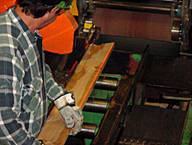 |
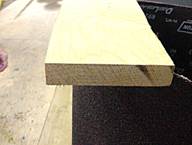 |
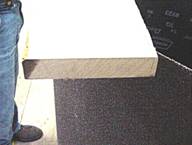 |
The pictures show similar results of carbide after three weeks and cermets after fourteen weeks. Both saws show about the same amount of "whiskering" or tear out and splintering on the bottom of the board.
This test was run at Cascade Hardwoods in Chehalis, Washington USA. Mike West is the Head Filer. The saw used is a "hula saw" which is a chop saw type of trim saw. The saw is a 20" X 100 tooth trim saw with zero degree hook. It is used to trim defective ends on planed or sanded, dry boards in the planer mill. The wood is dry Maple and Alder. The boards being cut are unsupported at one end. This Cermet saw has 14 weeks of use on it and has never been sharpened. The carbide saw on the other hula has three weeks use, which is about normal before needing re-sharpening. (The cermet saw eventually ran 20 weeks vs. 3 weeks for carbide)
New Tooling at Whittier Wood Products
Ceramic Tipped Saws reduce production expenses
This is a 14" X 80 tooth cermet tipped trim saw at Whittier Wood Products in Eugene, OR. It was run on one side of a Jenkins double end tennoner with a standard carbide saw on the other side. It was cutting dry alder in a furniture manufacturing plant. The cermet tipped saw ran 4 weeks before the user decided to change it out. It was still producing a satisfactory cut at that time, but they decided not to "push it". During the same period the carbide saw on the opposite side was changed 4 times because it was dull. These saws were cutting the same board, about 12" apart so they saw virtually equal amounts of identical wood. The customer was extremely pleased with the saw and its performance.
| Carbide | Cermet |
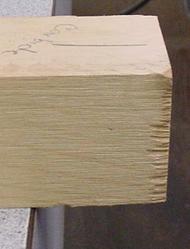 |
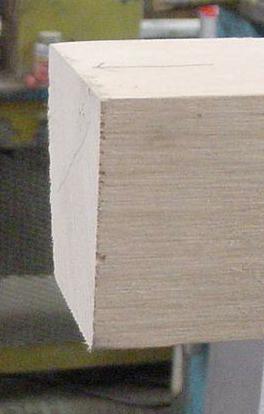 |
These are two ends of the same 4" X 4" board. The Cermet end is a much cleaner cut.
Western red cedar fencing from Tubafor in Morton, WA.
Cermet saws make a difference in grade worth as much as $0.30 per board
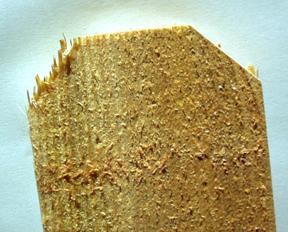 |
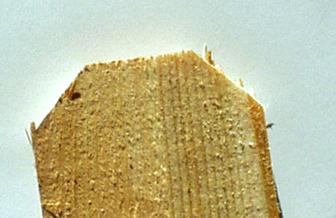 |
| Left Corner- Carbide after 1 week | Same board other side- Left corner above is Cermet after 1 week |
Tubafor in Morton, WA. makes western red cedar fencing and were having a problem with the machine that dog-ears their 4" boards. The machine does not support the rather narrow board very well and the product has a lot of "whiskering" which down grades a percentage of the product. The machine uses a 14" X 80 tooth trim saw. They put a cermet tipped saw on one of the two sawing positions on the machine and carbide on the other. They were thrilled with the improvement. There was very noticeably less whiskering on the cut made with the cermet than on the cut made with the carbide. The QC person was very pleased with the results and has made recommendations to continue and expand the use of cermets. They had only run one week when these pictures were taken and will leave the cermet saw on when they change the carbide saws to do a run life test.





